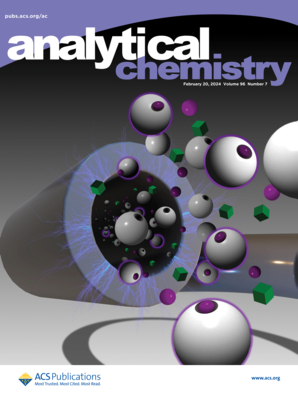Nanozyme Cascade Self-Powered H2O2 Strategy for Chemiluminescence Array Sensor to Monitor and Deactivate Multiple Bacteria
IF 6.7
1区 化学
Q1 CHEMISTRY, ANALYTICAL
引用次数: 0
Abstract
Early warning and deactivation of multiple bacteria are highly desirable to prevent pathogen-responsible bacterial infectious illnesses. Here, we developed a nanozyme cascade self-powered H2O2 strategy for a chemiluminescence (CL) array immunosensor to enable high-throughput and simultaneous monitoring of multiple bacteria as well as their deactivation. Specifically, a novel ZIF-67@CoFePBA yolk–shell nanozyme was synthesized through a dissociation and re-coordination mechanism, exhibiting significantly enhanced peroxidase (POD)-like activity due to the confinement and synergistic effects. ZIF-67@CoFePBA nanozyme was utilized to immobilize glucose oxidase (GOx) for constructing the nanozyme cascade self-powered H2O2 system. ZIF-67@CoFePBA nanozyme can catalyze in-situ H2O2 to produce hydroxyl radicals (·OH), resulting in stable glow-type CL to construct array immunosensors without exogenous H2O2. The self-powered CL array sensor was exploited to simultaneously detect numerous bacteria with wide linear ranges of 1.5×10–1.5×107 CFU/mL for Staphylococcus aureus and 1.5×102–1.5×107 CFU/mL for Escherichia coli. Furthermore, the generated ·OH can destroy the internal structure of the bacteria and effectively eliminate them. This study provides a promising insight into the design of self-powered H2O2 sensors for high-throughput and simultaneous detection of multiple bacteria and their subsequent deactivation.

求助全文
约1分钟内获得全文
求助全文
来源期刊

Analytical Chemistry
化学-分析化学
CiteScore
12.10
自引率
12.20%
发文量
1949
审稿时长
1.4 months
期刊介绍:
Analytical Chemistry, a peer-reviewed research journal, focuses on disseminating new and original knowledge across all branches of analytical chemistry. Fundamental articles may explore general principles of chemical measurement science and need not directly address existing or potential analytical methodology. They can be entirely theoretical or report experimental results. Contributions may cover various phases of analytical operations, including sampling, bioanalysis, electrochemistry, mass spectrometry, microscale and nanoscale systems, environmental analysis, separations, spectroscopy, chemical reactions and selectivity, instrumentation, imaging, surface analysis, and data processing. Papers discussing known analytical methods should present a significant, original application of the method, a notable improvement, or results on an important analyte.
 求助内容:
求助内容: 应助结果提醒方式:
应助结果提醒方式:


